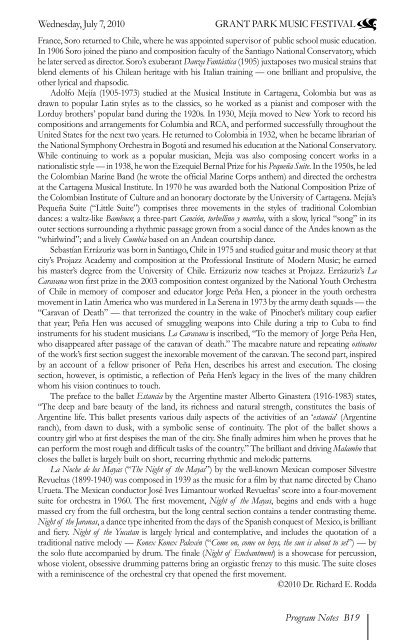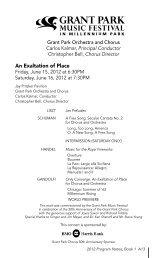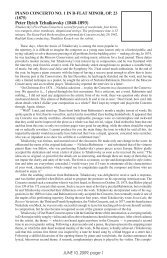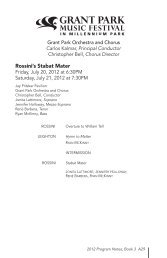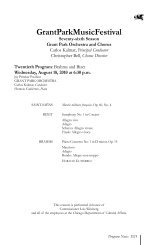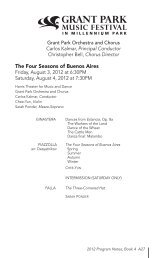Program Notes PDF - The Grant Park Music Festival
Program Notes PDF - The Grant Park Music Festival
Program Notes PDF - The Grant Park Music Festival
You also want an ePaper? Increase the reach of your titles
YUMPU automatically turns print PDFs into web optimized ePapers that Google loves.
Wednesday, July 7, 2010<br />
GRANT PARK MUSIC FESTIVAL<br />
France, Soro returned to Chile, where he was appointed supervisor of public school music education.<br />
In 1906 Soro joined the piano and composition faculty of the Santiago National Conservatory, which<br />
he later served as director. Soro’s exuberant Danza Fantástica (1905) juxtaposes two musical strains that<br />
blend elements of his Chilean heritage with his Italian training — one brilliant and propulsive, the<br />
other lyrical and rhapsodic.<br />
Adolfo Mejía (1905-1973) studied at the <strong>Music</strong>al Institute in Cartagena, Colombia but was as<br />
drawn to popular Latin styles as to the classics, so he worked as a pianist and composer with the<br />
Lorduy brothers’ popular band during the 1920s. In 1930, Mejía moved to New York to record his<br />
compositions and arrangements for Columbia and RCA, and performed successfully throughout the<br />
United States for the next two years. He returned to Colombia in 1932, when he became librarian of<br />
the National Symphony Orchestra in Bogotá and resumed his education at the National Conservatory.<br />
While continuing to work as a popular musician, Mejía was also composing concert works in a<br />
nationalistic style — in 1938, he won the Ezequiel Bernal Prize for his Pequeña Suite. In the 1950s, he led<br />
the Colombian Marine Band (he wrote the official Marine Corps anthem) and directed the orchestra<br />
at the Cartagena <strong>Music</strong>al Institute. In 1970 he was awarded both the National Composition Prize of<br />
the Colombian Institute of Culture and an honorary doctorate by the University of Cartagena. Mejía’s<br />
Pequeña Suite (“Little Suite”) comprises three movements in the styles of traditional Colombian<br />
dances: a waltz-like Bambuco; a three-part Canción, torbellino y marcha, with a slow, lyrical “song” in its<br />
outer sections surrounding a rhythmic passage grown from a social dance of the Andes known as the<br />
“whirlwind”; and a lively Cumbia based on an Andean courtship dance.<br />
Sebastían Errázuriz was born in Santiago, Chile in 1975 and studied guitar and music theory at that<br />
city’s Projazz Academy and composition at the Professional Institute of Modern <strong>Music</strong>; he earned<br />
his master’s degree from the University of Chile. Errázuriz now teaches at Projazz. Errázuriz’s La<br />
Caravana won first prize in the 2003 composition contest organized by the National Youth Orchestra<br />
of Chile in memory of composer and educator Jorge Peña Hen, a pioneer in the youth orchestra<br />
movement in Latin America who was murdered in La Serena in 1973 by the army death squads — the<br />
“Caravan of Death” — that terrorized the country in the wake of Pinochet’s military coup earlier<br />
that year; Peña Hen was accused of smuggling weapons into Chile during a trip to Cuba to find<br />
instruments for his student musicians. La Caravana is inscribed, “To the memory of Jorge Peña Hen,<br />
who disappeared after passage of the caravan of death.” <strong>The</strong> macabre nature and repeating ostinatos<br />
of the work’s first section suggest the inexorable movement of the caravan. <strong>The</strong> second part, inspired<br />
by an account of a fellow prisoner of Peña Hen, describes his arrest and execution. <strong>The</strong> closing<br />
section, however, is optimistic, a reflection of Peña Hen’s legacy in the lives of the many children<br />
whom his vision continues to touch.<br />
<strong>The</strong> preface to the ballet Estancia by the Argentine master Alberto Ginastera (1916-1983) states,<br />
“<strong>The</strong> deep and bare beauty of the land, its richness and natural strength, constitutes the basis of<br />
Argentine life. This ballet presents various daily aspects of the activities of an ‘estancia’ (Argentine<br />
ranch), from dawn to dusk, with a symbolic sense of continuity. <strong>The</strong> plot of the ballet shows a<br />
country girl who at first despises the man of the city. She finally admires him when he proves that he<br />
can perform the most rough and difficult tasks of the country.” <strong>The</strong> brilliant and driving Malambo that<br />
closes the ballet is largely built on short, recurring rhythmic and melodic patterns.<br />
La Noche de los Mayas (“<strong>The</strong> Night of the Mayas”) by the well-known Mexican composer Silvestre<br />
Revueltas (1899-1940) was composed in 1939 as the music for a film by that name directed by Chano<br />
Urueta. <strong>The</strong> Mexican conductor José Ives Limantour worked Revueltas’ score into a four-movement<br />
suite for orchestra in 1960. <strong>The</strong> first movement, Night of the Mayas, begins and ends with a huge<br />
massed cry from the full orchestra, but the long central section contains a tender contrasting theme.<br />
Night of the Jaranas, a dance type inherited from the days of the Spanish conquest of Mexico, is brilliant<br />
and fiery. Night of the Yucatan is largely lyrical and contemplative, and includes the quotation of a<br />
traditional native melody — Konex Konex Palexén (“Come on, come on boys, the sun is about to set”) — by<br />
the solo flute accompanied by drum. <strong>The</strong> finale (Night of Enchantment) is a showcase for percussion,<br />
whose violent, obsessive drumming patterns bring an orgiastic frenzy to this music. <strong>The</strong> suite closes<br />
with a reminiscence of the orchestral cry that opened the first movement.<br />
©2010 Dr. Richard E. Rodda<br />
<strong>Program</strong> <strong>Notes</strong> B19


